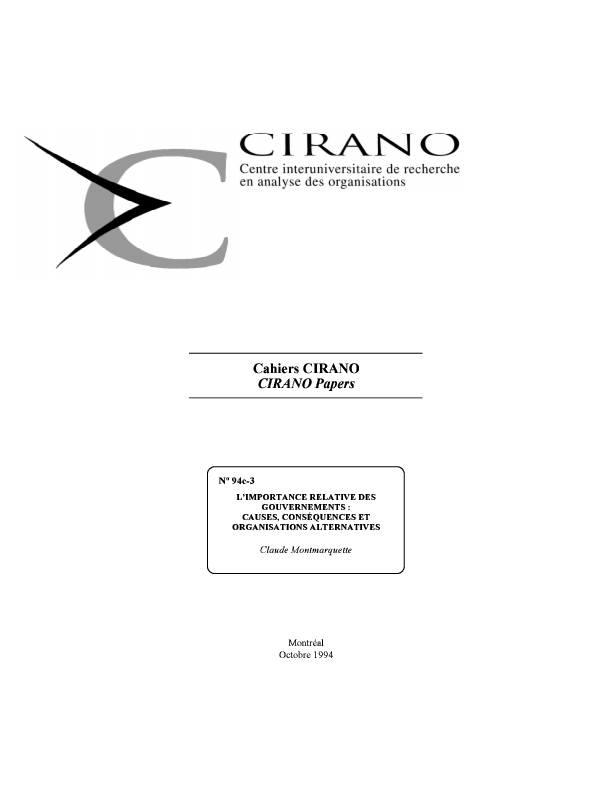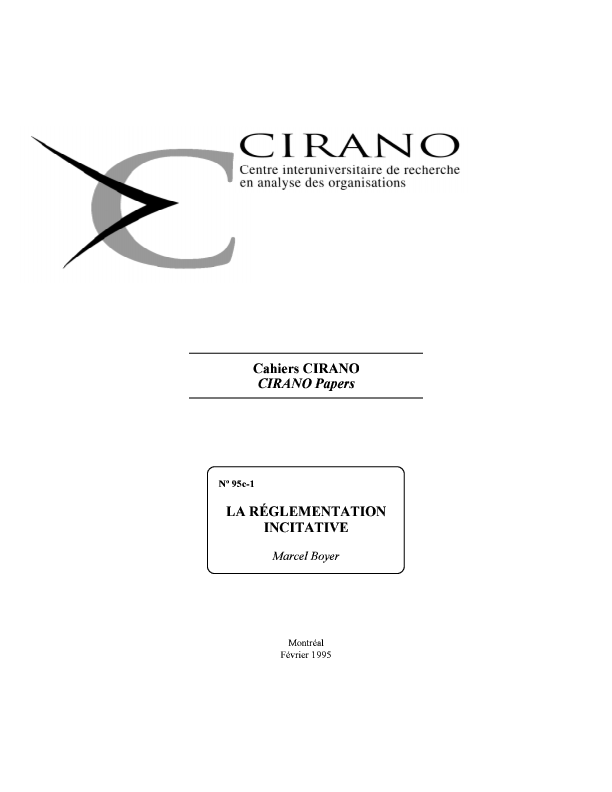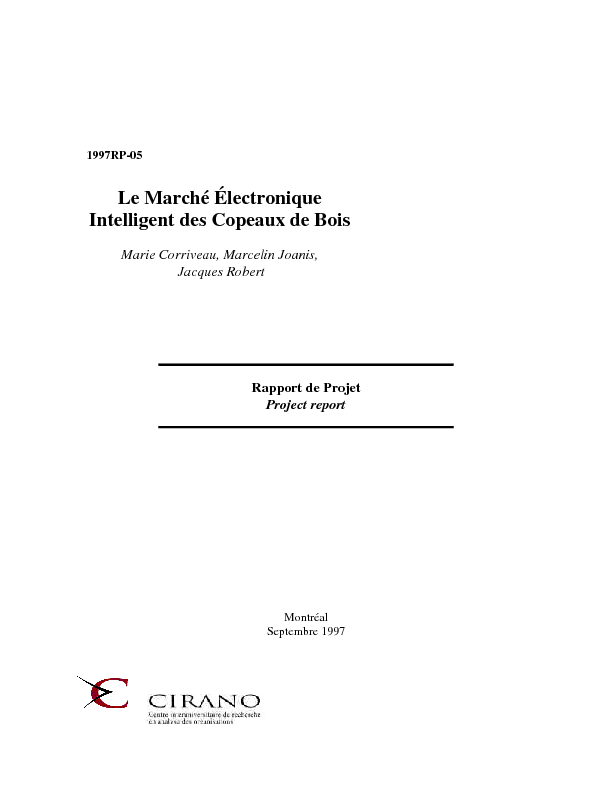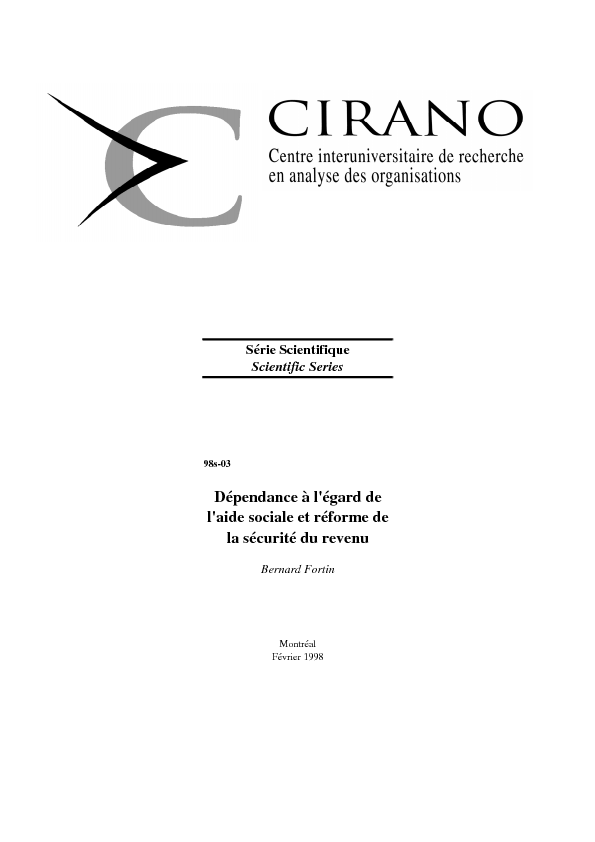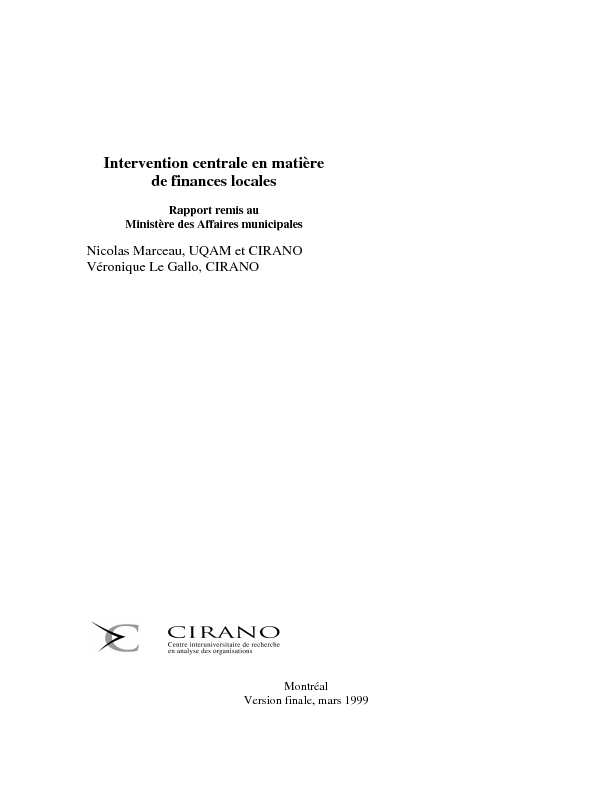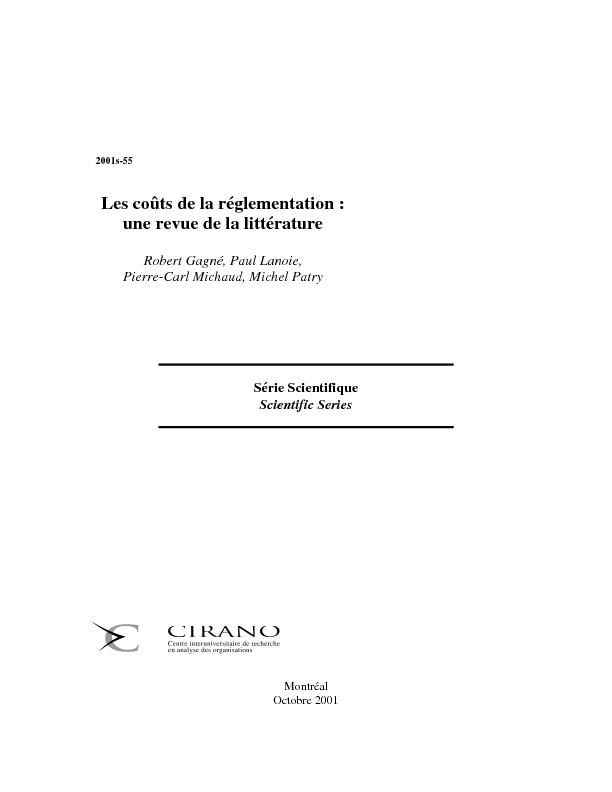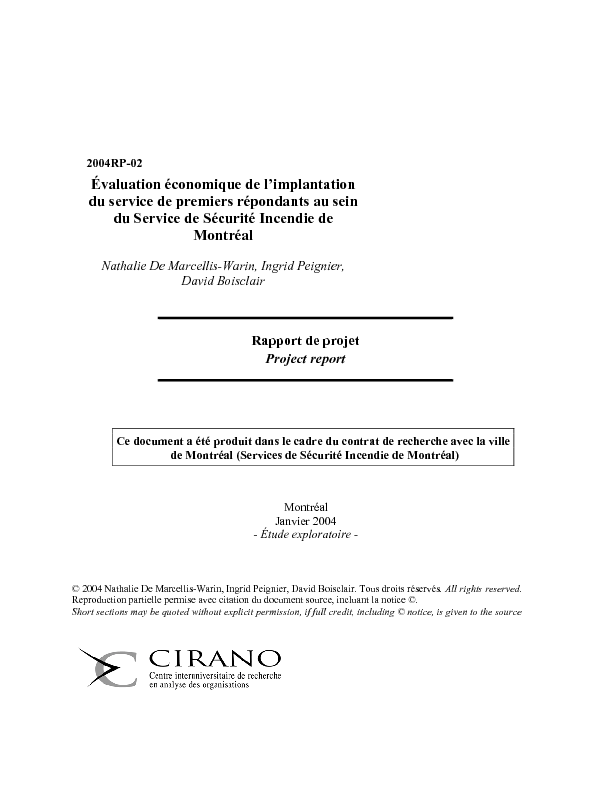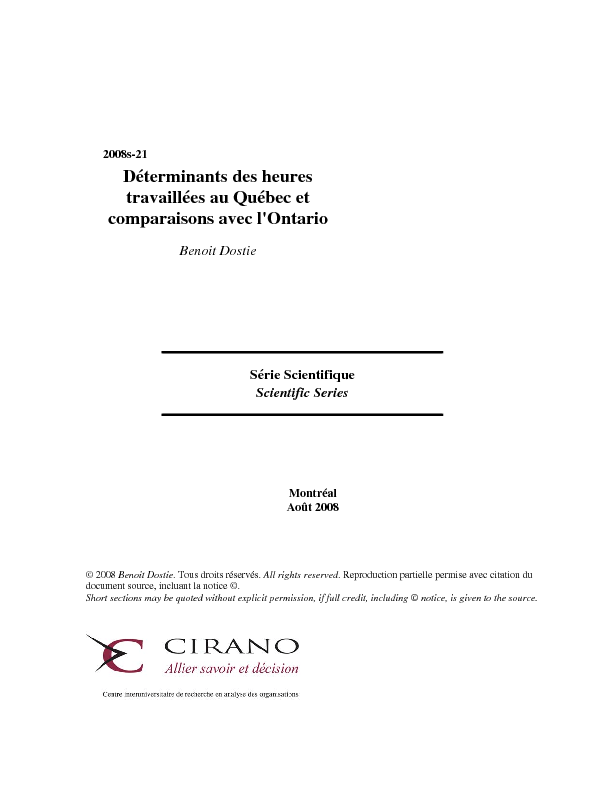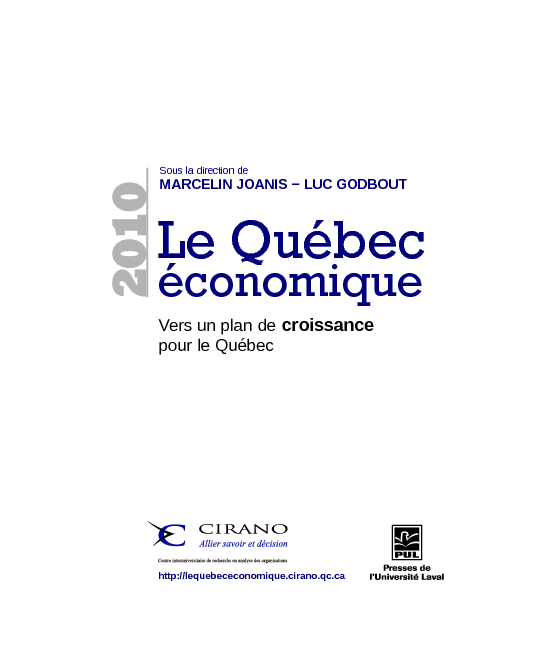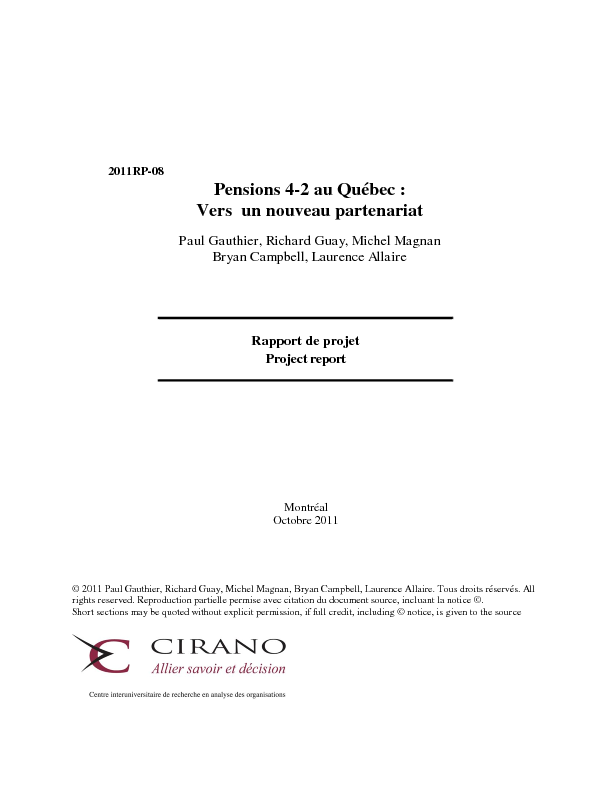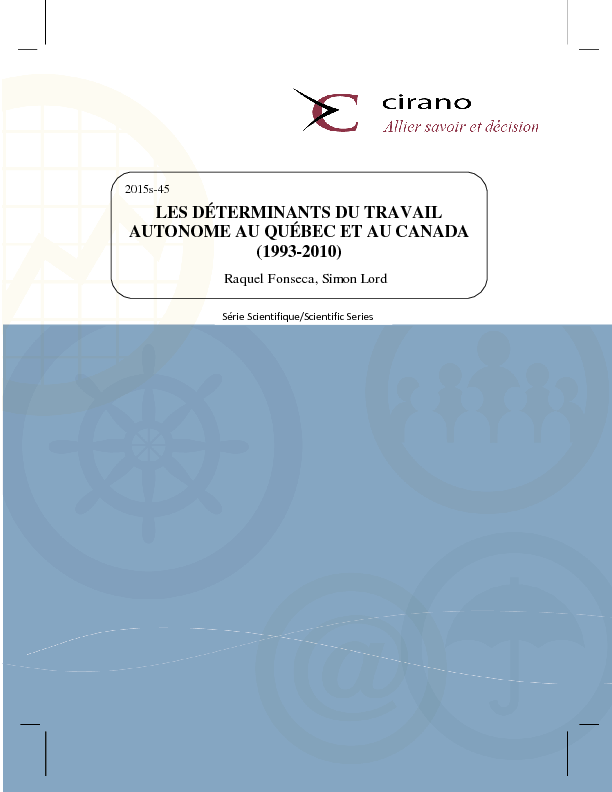Since its creation, CIRANO has had more than 1600 publications. On the occasion of CIRANO's 25th anniversary, we wanted to highlight the contributions of our speakers by means of a list of 25 of their texts published in French at CIRANO, one per year from 1994 to 2018. These 25 texts cover a wide range of themes related to the Quebec economy or public policies. After the conference, a revised version of this list will be used as a basis for the production of a book marking the 25th anniversary of CIRANO by publishing excerpts from these texts accompanied by a contemporary context by their original authors.
It goes without saying that many other publications could have been included in this list. It is not a compilation of the "best texts", or a compilation of the most cited texts. We invite you to delve into 25 years of contributions to Quebec policy research through a search in our publications database, where you will be able to access all CIRANO publications by a particular author.
In Canada as in Quebec, every second dollar is spent by the government. This is a considerable proportion of the total expenditure of an economy left to the decision of the political market. This proportion is one of the highest among the so-called capitalist countries. Faced with this situation, economists, among others, have tried to understand the origin of such a situation, and especially to identify the consequences of the omnipresence of the State on well-being, development and economic growth. In this paper, we examine four roles attributed to the state in our society: the production of goods and services; the reduction of income inequality; the stabilization of the economy; and finally the0501ntaining economic growth. Our reflection and studies lead us to conclude that the State essentially produces private goods collectively financed and that it has little impact on income inequality. In addition, we show that there is an incompatibility between the ability of governments to stabilize the economy and a high relative size of the state. Finally, a high relative size of the state appears to be detrimental to economic growth. In conclusion, we suggest a different organizational context that would allow for greater efficiency in the delivery of services currently provided by the State.
[ - ]This study presents the foundations and objectives of business regulation in Canada. An overview of the main theoretical findings in regulatory economics over the past 10 years and a price-cap analysis of regulation introduced in England in 1984 provide key lessons and recommendations for improving the effectiveness of regulatory mechanisms in Canada: promote deregulation, promote price-cap regulation in full disclosure contexts, promote price-cap regulation with marked competition in incomplete disclosure contexts where the existence of information annuities can be tolerated, promote incentive regulation with marked competition in incomplete disclosure contexts where the existence of information annuities is difficult to accept, and finally establish an appropriate body, independent of governments and regulated companies, to review regulation and to inform and educate the public about these changes.
[ - ]In the recent economic history, work sharing has been a subject for discussion and thought at three distinct periods: during the Great Depression of the thirties, at the time of the late seventies' recession, and since the beginning of the nineties. These three periods are characterized, not only by a high unemployment rate, but also, and maybe0501nly, by a very high level of pessimism towards the possibility of an eventual employment pickup that would de strong enough to integrate both those who lost their jobs, and those freshly arrived arrived on the job market. Is work sharing the solution to this problem ? This paper summarizes what we already know on the impact onto employment of regulating work hours, shows, using a concrete case, the difficulty of reducing work hours to stabilize employment while0501ntaining the same level of productivity, and concludes with a few warning remarks on the expectations that arise when work sharing is viewed as a solution to the unemployment problem.
[ - ]This document presents the draft of an intelligent electronic market, adapted to the Quebec wood chip industry. Its purpose is to explain how such a market works and to show how it fits into or changes the current trading system. The proposed smart electronic marketplace has two main objectives. The first objective is to improve the efficiency of the wood chip market. The electronic market is a privileged means of improving market flexibility and thus stopping the accumulation of unsold stocks. Such a mechanism maximizes the industry's overall profits by ensuring that each company can identify all the business opportunities within its reach and exploit the additional profits associated with them. The second major objective is continuity in business practices. Long-term contracts between sawmills and paper mills are an important market reality and will be an integral part of the smart electronics market.
[ - ]The principal aim of this paper is to present an analysis of the factors that influence the dynamics of welfare spells among households. Four sets of variables are distinguished: variables that affect work conditions and individual preferences; variables that influence labour market rationing; parameters of the welfare program and of other social programs. A particular emphasis is put on the dynamic nature of welfare dependency and on the links relating present and future welfare participation. Econometric results applied to Quebec are also discussed. Finally, conclusions from this analysis are drawn concerning the recent welfare reform proposed by the Quebec Government.
[ - ]Quebec municipalities face a critical financial crisis. Both their main sources of income, (governmental transfers and land taxes) are diminishing while demands from taxpayers multiply. The 80's economic crisis has slowed down the growth rate of commercial and industrial investments, thus reducing the sources of income. Moreover, since higher governments prioritise deficit reduction, intergovernmental transfers towards municipalities have been reduced. This situation is not particular to Quebec, all over the world, municipalities have taken on a greater number of responsibilities and have witnessed serious reduction in their budgets. In this report, we examine the measures taken by central governments in response to the difficult financial standing of municipalities. The report is divided into six parts, each one analyzing, from an economic standpoint, the measures undertaken by central governments in response to municipal financial problems. We discuss issues such as municipal mergers, control of municipal debt, taxes in general, the concept of user/payer, municipal equalization and competition between municipalities.
[ - ]In this paper, we have examined the over-representation of women in the university sector as a whole and their under-representation in the pure and applied sciences. Paving the way for concrete responses, our overview of the economic literature examined the determinants of university students' choice of fields of study. It was found that students who faced multiple choices of study disciplines discriminated between programs based on anticipated income differentials, the likelihood of finding employment, the atrophy of knowledge in science, and the value of some degrees that facilitate the transition to higher education. Although these variables significantly explain the choice of students' programs of study, a significant residual portion of the gender gap in choice remains unexplained. We suggest that a number of idiosyncratic preferences of women and men could explain this residual portion, but that data on student preferences in Quebec were not available in the current survey. To fill this gap, laboratory experiments currently underway at CIRANO will soon shed substantial light on risk aversion and the distinctive degree of cooperation between men and women. We believe that these two factors play an important role in students' decision-making processes and their measurement, in addition to enriching current educational knowledge, would pave the way for the development of policy interventions.
[ - ]It is now well recognized that all types of regulation are imposing costs on our society. The studies which have tried to evaluate these costs are numerous and their methologies are diversified. This paper is proposing a critical analysis of these methodologies and of the results obtained by researchers who have tried to evaluate the costs of regulation. Before that, however, we develop an analytical framework for examining the impact of regulation on firms'costs, economic efficiency and the well-being of the population in general. This section will be based on cost-benefit analysis
[ - ]The price of an option should reflect the average value that a buyer receives for it, and also a risk premium. This report describes an empirical study for analysing these factors as a graphical and quantitative manner. The analysis focuses on the average difference between the price option and its present average value at maturity (the bias), and tries to detect some temporal regularities in the pattern of this bias. We found some very surprising almost-periodic patterns for the bias, in particular for the long-time maturities (not so clearly for the puts), as studied by spectral analysis.
[ - ]The general interest would require that the use of major equipments be priced at their marginal cost, including all opportunity costs such as congestion and pollution costs. At least, prices should be lowered until full utilization of these equipments is obtained. This is a result that economists call the first best solution. Unfortunately, under increasing returns to scale, such prices lead to a deficit. In order to covers all monetary costs, the managers must then fix prices above the marginal costs. In the general interest, they should do so while trying to preserve as much as possible the first best features, i.e. by maximizing the use of these equipments for the largest well being of the citizens. This is what economists call a second best solution, i.e. the best solution given the budget balance constraint. The problem is to find the prices that will meet this objective. These are the questions addressed in this report. We start with the Ramsey-Boiteux or linear pricing. In this case, there is only one price for each good or service, although prices may vary from one category of customers to the other. Next, we show that one can do better with multi-part or non-linear prices, comprising fix charges, usage fees, etc. The report ends with a brief survey of actual applications of linear and non-linear prices.
[ - ]This report, about the implementation of first responder service in Montreal, fits in the context of the new Quebec act on prehospital emergency care passed on December 2002 (Bill 96), and also in the context of the merger of fire services in Montreal. The CIRANO was contracted to perform an economic analysis of the implementation of a first responder service in Montreal involving the evaluation of the costs associated with this type of services, as well as the benefits that it brought to the society (especially the reduction of public healthcare costs). On-going research shows that the existence of such services present considerable potential (in terms of effectiveness and impacts), even if some problems of financing and organizing aren't to neglect. Thus the CIRANO's research project regroups all the elements necessary to conduct the economic analysis about the implementation of a first responder service in the Montreal fire department as well as to evaluate its profitability (methodology used for the cost/benefit analysis is also explain).
[ - ]This is not a new observation: Quebec is highly indebted. Relatively speaking, Quebec is the third Canadian province with the most indebted government. Quebecers also have to bear the even greater burden of federal public debt. Despite this, the Government of Quebec still does not have an explicit policy on this issue, unlike the federal government. In fact, despite the achievement of a balanced budget in 1998-1999, Quebec's debt has continued to increase significantly and, over the past two fiscal years, the government has reported budget deficits. The governments of Quebec and Canada have both experienced a decline in their public finances since the mid-1970s, incurring debt not only to finance their capital expenditures but also their annual operating expenses. This is primarily due to a series of macroeconomic shocks (oil price shocks, recessions), and then to the propensity of governments to spend beyond their ability to pay by relying on possible economic growth that has not materialized. Today's Quebec taxpayers therefore inherit not only a high level of debt but, above all, a debt that has essentially no tangible counterpart in terms of profits. Public debt is a mechanism that allows the collection of taxes to be deferred for the financing of public expenditure. It allows the tax burden associated with certain shocks to be spread over time, to bring the tax burden and benefits associated with government spending closer together over time, and to redistribute wealth between generations. However, the use of public debt is limited by a set of problems associated with high public debt. These problems concern public finances, macroeconomic conditions, economic efficiency, intergenerational equity and the political environment. There is no consensus among economists on the optimal level of public debt. However, there is a relatively broad consensus, at least in Canada, that current debt levels are too high. In particular, Quebec now appears to be very far from the level of indebtedness it would have experienced if it had respected the "traditional rule", i.e. if it had gone into debt only to finance its capital investments. There are three options for a government that wants to reduce its debt burden: rely on economic growth to "automatically" reduce the relative size of public debt, make annual repayments of part of the debt, or sell some assets and allocate the resulting amounts to debt repayment. The only recourse to the effect of economic growth is a risky policy. Debt repayment itself is characterized by a trade-off between short-term sacrifices (lower public spending or higher taxes) and greater flexibility in the future. Finally, the sale of assets must be considered with caution because of the importance of Crown corporation revenues in the Québec government's budget. An appropriate policy for the Government of Quebec could include: the creation of an annual contingency reserve and a stabilization fund, the use of the reserve as often as possible to repay debt, and the sale of certain public assets to accelerate debt reduction. This proposal has the threefold advantage of increasing the credibility and prudence of Québec's budgetary policy, recognizing the need for certain short-term public investments and being an effective response to the future pressures that will accompany an aging population. Translated with www.DeepL.com/Translator
[ - ]This CIRANO report is an introduction to the issues of nanotechnology. The aim is to provide an overview of the issue, to define what nanotechnology is, to assess its scope in terms of applications, to know the main actors and to be able to get an idea of the potential dangers that this dynamic field could entail. However, this text is far from being a complete report on the issue, as it is so vast and expanding. Nanotechnologies are likely to be the lifeblood of the next technological revolution. Emerging since the late 1990s, their breakthroughs will revolutionize all technological and scientific fields. Nanotechnologies and nanosciences have the scientific particularity compared to the other fields they operate in at nanometric dimensions, where the material being manipulated has new properties that have not yet been used. On the other hand, the success of research in the field of nanotechnologies can only result from the convergence of the efforts of several actors operating in different scientific and technological disciplines (computer science, mathematics, engineering, chemistry, physics, biology, etc.). The various applications in nanotechnology can be grouped into three main fields: nanomaterials, nanoelectronics and nanobiotechnologies. Nanomaterials represent the most promising application area for short-term commercialization. By acting directly on the assembly of particles forming certain conventional materials, we are able to considerably improve their physical properties (such as strength or conductivity). In nanoelectronics, the miniaturization limitations of conventional photolithography techniques will soon be overcome by a series of new techniques, some more promising than others. The transformations in electronics that will result from these breakthroughs will be radical (nanorobots, bionics, etc.). Nanotechnologies finally hold many promises for human health. They will allow us to observe nature more closely (from within the cells themselves) in order to correct its dysfunctions (such as nanobots acting in our arteries as plumbers capable of preventing clogging of the ducts by destroying cholesterol). However, there are less pink aspects to any new product. As the state of progress of nanosciences and nanotechnologies does not yet allow us to know them and to properly assess the dangers, the current trend is to minimize them, given the extent of the applications envisaged. However, the problem is increasingly being raised in the scientific community. In terms of the environment, the potential risks would be linked to the fact that the market will be able to put into circulation nanomaterials with beneficial properties, but whose counterpart would be the absence of tested and approved recycling techniques. The production and storage of new materials are also subject to risk, given the increased reactivity of some of them. In the field of health, some risk analyses have been carried out. The main difficulty with this type of study is that the great diversity of nanomaterials already in existence means that there will be no uniform diagnosis. Laboratory tests have been carried out on rats to assess the health effects of carbon nanotubes, and the conclusions are not unanimous. There is therefore still a lot of work to be done. In any case, it can already be anticipated that the analysis of the environmental and human health impacts of nanoproducts will have to be based on a holistic approach that takes into account the entire life cycle of the product or process. In short, nanotechnologies are a radical innovation that will eventually transform many aspects of economic life, and could help pave the way for sustainable development. However, there is a need to improve rapidly the risk analysis of these technologies in order to avoid pitfalls similar to those that still hinder the development of some other technologies (e.g. those resulting from genetic engineering).
[ - ]There is a widespread belief that environmental protection is associated with increased costs imposed on businesses by government. Over the past decade, this view has been challenged by a large number of analysts. They have identified many opportunities, conceptually or theoretically, to offset costs with higher benefits for companies' efforts to ensure environmental sustainability. First, better environmental performance can lead to increased revenues through: (i) better access to certain markets, (ii) the ability to differentiate products and (iii) the ability to sell pollution control technologies. Second, better environmental performance can result in cost reductions in the following categories: (iv) regulatory costs, (v) material, energy and services costs, (vi) capital costs and (vii) labour costs. The objective of this report is to provide empirical evidence of the existence of these opportunities and to assess their magnitude. For each of the seven possibilities mentioned above, we study the inherent mechanisms and propose a systematic overview of the existing empirical evidence. This report does not seek to demonstrate that pollution reduction is always accompanied by better financial performance; rather, it argues that expenses incurred to reduce pollution can sometimes be partially or fully offset by gains from other sources. Through a systematic review of all options, we aim to identify the circumstances that are most likely to lead to a "win-win" situation - better environmental and financial performance.
[ - ]In this article, we estimate the determinants of hours of work for Ontario and Quebec using Statistics Canada Labour Force Surveys. We first illustrate that intensity hours worked per employed person - has decreased in Quebec relative to Ontario between 1997 and 2005. We then proceed to show that differences in average observed characteristics between the two provinces explain at most 10 % of the difference. We next analyze in more details the impact of industry, occupation, public sector status and union status on the distribution of hours of work. We find that if the size and distribution of unions in Quebec were the same as in Ontario, the proportion of workers in Quebec working reduced hours would decrease significantly while the proportions working long or very long hours would increase.
[ - ]A country, region or the entire planet falls into recession when its economic activity slows for the most part below its usual growth rate. An inevitable consequence is an increase in unemployment. In 2009, the global economy is in recession. There is a double surprise. First, this is the first time a global recession has been observed since the relevant data began to exist (1980). But what is quite spectacular is that all regions of the world are simultaneously in recession. The recession is global and synchronized.
[ - ]On October 9, 2008, Les Affaires titled "Biotechs on the verge of extinction". According to the article, Quebec biotechnology companies own two and a half times less capital than their counterparts in the rest of Canada. Less than two years later, the biopharmaceutical sector in Quebec is at the top of venture capital investment, with $38 million financing seven Quebec companies in the second quarter of 2010 (Chaurette and Béïque, 2010). Will this influx of money succeed in pulling the industry out of its slump?
[ - ]Quebecers with incomes of $40,000 or less, who have contributed to the QPP throughout their careers, are generally well covered by the retirement income programs currently in place, which are also referred to as Pillars I and II of the Quebec and Canadian pension systems. Less well covered are private sector workers with incomes in excess of $40,000 who are not part of an employer-sponsored pension plan. Their number is estimated at around 800,000 workers. The challenges facing these workers are all the greater as the financial reality indicates that savings must begin when you are young to have a tangible impact on retirement income. However, this unavoidable reality of financial planning is confronted with the needs and requirements of everyday practical life. At age 30, retirement concerns are less pressing than developing a career, establishing and supporting a family and maintaining a general lifestyle appropriate to their current and expected income. In this context, it is probably too optimistic to assume that rational and optimal savings decisions are indeed being made. However, the goal of saving for retirement remains important. Indeed, life expectancy is increasing and this phenomenon leads not only to a longer period to finance for retirement but also to a potential increase in medical expenses, with the fear that some may not be fully covered by the public health system. Are Quebecers ready to face such a possibility? The main objective of this report is to propose mechanisms through which Quebecers are encouraged to save more. These are grouped under the general heading of Pensions 4-2.
[ - ]This report presents a reflection and recommendations on the financing of Ville de Montréal's boroughs. A consultation tour of the 19 boroughs, meetings with key stakeholders from the main central services and a review of several documents provided mainly by the Finance Department made it possible to establish a diagnosis of the situation. The problem of financing the boroughs stems from the establishment of historical budgets in 2002, which were considered relatively inequitable, and from the inability to migrate since then to budgets based on objective and uniform parameters for all the boroughs. The boroughs' participation in their financing remains relatively low and the austerity climate imposed by the City in recent years has caused a lot of frustration. Following this site review in Chapters 1 and 2, and using the principles of intergovernmental financial relations to be applied in a decentralized city context, we put forward eight main recommendations aimed at clarification, accountability and stabilization: That the services delegated to the boroughs by Ville de Montréal be clarified in terms of responsibility and funding; That participation in interborough services follow more equitable fixed cost sharing rules and that charges better reflect actual costs; That the responsibility for property management be clarified, fully assumed by the entity responsible for it (no sharing) and that appropriate rents be applied; That the network components of borough services be better identified and adequately funded. Network components that require a processing change have been identified in the following services: - Libraries - Roads and snow removal (portion affecting inter-borough transit streets) - Residual material collection - Sports and leisure centres That the boroughs themselves raise a portion of their core revenues from local property taxes (with equalization payments for the less fortunate); That the mooring between responsibilities and various sources of revenue, particularly from parking and advertising, be reviewed; That the envelope for central transfers to the boroughs be indexed to inflation and that it be based entirely on objective parameters (parametric budget) with a transition period; That the Development Fund, which has become useless through all these proposals, be abolished; That the distribution formula for the TNP be reviewed. All these proposals are intended to standardize the financial treatment of the boroughs and put an end to the legacy of historical budgets that has persisted since 2002. They are intended to make the City of Montréal's structure more efficient, in a context of reasoned decentralization, taking into account the network effects of services to the boroughs.
[ - ]This report provides a statistical portrait of the labour market situation of immigrants in Quebec compared to Ontario and British Columbia. We analysed this situation from two angles, quantitative (activity and unemployment rates) and qualitative (working conditions), over a sufficiently long period of time to neutralise the cyclical effects and draw solid conclusions. Empirical data are from the Labour Force Survey (LFS) for the period 2006-2012 and refer to the population aged 15 to 64. Quantitatively, our results support those of previous studies that access to employment is more difficult for immigrants from Quebec than from other Canadian provinces, particularly British Columbia. They also indicate that this situation is far from temporary, since immigrants in Quebec face a high double-digit unemployment rate and this disadvantage persists over time. However, the analysis of terms and conditions of employment provides a downside to British Columbia's good performance relative to Quebec in terms of immigrant employment. Indeed, this performance is essentially due to the greater propensity of immigrants in British Columbia to opt for self-employment and to accept lower quality jobs. They are also relatively more likely to rely on their network of family and friends when looking for work. In fact, this province is far from being a model for the economic integration of immigrants despite low unemployment rates among them. Finally, we note the important role that the place of graduation plays in access to employment ñ especially in Quebec ñ and in the quality of employment. In all three provinces studied, immigrants who graduated in Africa, Asia or the Americas (except the United States and Canada) are significantly disadvantaged. However, these regions are by far the main sources of immigration to Quebec and Canada. All in all, Quebec ñ like Ontario and British Columbia ñ is far from making the most of the resources available through immigration. As a result, provincial and federal governments will need to focus more on promoting the full use of these resources through the effective participation of immigrants in the labour market.
[ - ]This working document provides an overview of the current state of international trade in waste. It describes the evolution and composition of flows and introduces the major players in international trade. He then discussed the Basel Convention, the pollution haven and the illegal waste trade. This work is partly based on Bernard et al (2012) which focuses, in particular, on the French context.
[ - ]This paper studies the determinants of self-employment in Québec and in the rest of Canada by focusing on liquidity constraints, age and aggregate unemployment. We use a random effects probit model to analyse panel data from the Survey of Labour and Income Dynamics (SLID) for the period 1993-2010. The main results are as follows. The positive effect of investment income on the probability of being self employed confirms the existence of liquidity constraints. Being older increases the probability of choosing self-employment, rather than salaried work. This suggests that working for oneself may be a stepping stone towards retirement. High unemployment decreases the probability of being self-employed, suggesting that pull factors dominate push factors.
[ - ]We evaluate the predictability of the economic activity of Quebec in a data-rich environment. In our framework, the province of Quebec is treated as a regional economy that is exposed to the influence of the Canadian and American economies. Three large information sets are used: data from Quebec, Canada and the US, for a total of 453 macroeconomic variables. We compare a large number of models for the purpose of identifying those that are most efficient at forecasting macroeconomic aggregates of Quebec such as the GDP, employment, inflation, investment, etc. Our results suggest that the best model in terms of mean squared error depends on the variable of interest and on the forecasting horizon. A model that performs well at short horizons does not necessarily perform well at long horizons. Likewise, the model that best predicts the nominal GDP does not necessarily win the race when it comes to predict the real GDP. The ARMA(1,1) is found to be one of the best standard models to predict the nominal GPD and inflation. Models exploiting rich data sets often rank best individually. The most robust performances are obtained by averaging the forecasts delivered by the 5, 10 or 20 best individual models.
[ - ]Health care systems in many countries have been in transformation for several decades now. They are subject to demographic and epidemiological changes in the populations served on the one hand, and technological changes that directly influence professional practices on the other. These are all factors that create pressures for the transformation of the work of key stakeholders in health care institutions, nurses and physicians. In the context of rising costs and a shortage of specialized resources, institutions and decision-makers are faced with the challenge of optimizing the use and efficiency of these key stakeholders. The objective of this study was to draw a portrait, based on the published scientific literature, of the activities carried out by health professionals during their working hours. The research questions asked were as follows: (1) What are the activities carried out by health professionals (doctors and nurses) and how are they defined? (2) What is the share of clinical (patient-care-related) and non-clinical (non-patient care-related) activities performed by health professionals (doctors and nurses) during their working hours? (3) What proportion of non-clinical activities performed by physicians and nurses may not be part of their work? How do these activities affect the efficiency of the organization of care?
[ - ]This document presents the MegBec multiregional model of Quebec, a recursive dynamic computable general equilibrium (CGE) model with 16 “analytic” regions. The model is based on a social accounting matrix (SAM) with 44 industries and 63 products. The first part of the document describes how the SAM was constructed. First, a SAM for Quebec as a whole was elaborated, using the 2011 Statistics Canada supply and use tables. Regional SAMs were built from that one by distributing values across regions following several key indicators, particularly the regional GDP estimates of the Institut de la statistique du Québec. The resulting discrepancy in each region between salaries received and paid is attributed to worker commuting; origin-destination flows were estimated using cross-entropy minimization from Statistics Canada’s 2011 Census commuting data. Discrepancies between regional absorption and production are attributed to interregional trade; bi-lateral flows are generated by simulation using a gravity model. Attraction factors – key parameters in the gravity model – are obtained by aggregating attraction factors constructed at the finer Municipalité Régionale de Comté (MRC) spatial scale, according to network distances, in minutes, between population-weighted centroids. The second part of the document persents the model itself, whose specification is more or less standard for dynamic multiregional CGE models. In particular, trade between regions follows the Armington imperfect substituability hypothesis: supply is apportioned according to constant-elasticity-of-transformation (CET) functions, and demand according to constant-elasticity-of-substitution (CES) functions. Regional labor markets are characterized by the presence of unemployment, the rate of which depends on the level of wages, following a wage curve. Interregional worker commuting flows are logistic functions of regional wage rates. The document includes several appendices, one of which describes the reference scenario and the closure rules that are applied by default in the model.
[ - ]